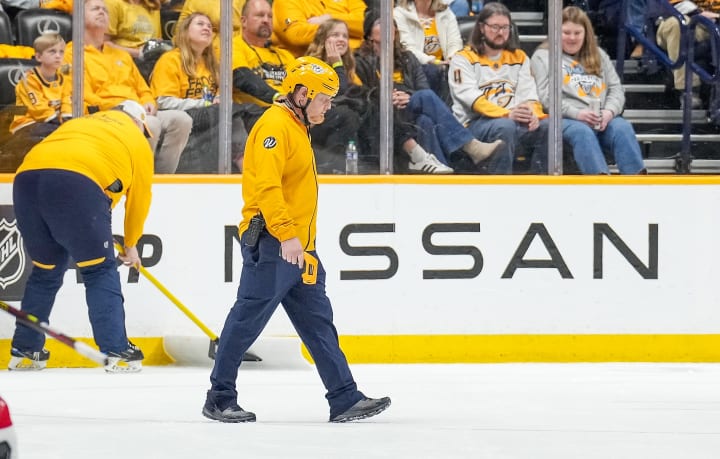Your Questions Answered as Predators Operations Team Reinstalls Ice at Bridgestone Arena for 2024-25 Season
Your Questions Answered as Predators Operations Team Reinstalls Ice at Bridgestone Arena for 2024-25 Season
Nigel Schnarr, Senior Director of Ice Operations, Responds to Smashville’s Queries as Ops Team Prepares Ice Rink for Game Time

Upon returning to 501 Broadway after the extended holiday weekend, the Nashville Predators front office reported a noticeable drop in temperature compared to the past few months.
And for good reason.
The operations staff at Bridgestone Arena spent Tuesday working on their biggest offseason task: reconstructing the 200-foot frozen playing field from the ground up. This comes as the 2024-25 NHL regular season is fast approaching, being just over five weeks away.
The ice is going back in at @BrdgstoneArena nature is healing pic.twitter.com/b9mH2IDtas
— Nashville Predators (@PredsNHL) September 3, 2024
Nigel Schnarr, Senior Director of Ice Operations, is spearheading the crucial job for his 11th season with the Predators. We solicited Schnarr, with his years of experience and intriguing insider knowledge, to answer some of your most common questions about the multi-day process. The questions range from the ice’s temperature to the massive amount of water used throughout the process.
Let’s get right into it:
What is the step-by-step process to making the ice at Bridgestone Arena?
We began with a concrete slab and initiated the freezing process yesterday. At approximately 1:00 PM, the temperature was around 70 degrees Fahrenheit, but by this morning, we had decreased it to about 16 degrees. Today, our objective is to seal this concrete slab. I’ve already done a large-scale flooding using a fire hose, and our next step is to cover it with three to four layers of white paint. This will ensure that the concrete is completely concealed. We’ll then seal this with about five layers of clear water.
Once this is finished, we’ll proceed to mark the blue and red lines, face-off circles, hash marks, and goal creases before painting them. All these markings will be painted by hand. After these steps are completed, we’ll start to position our logos in the neutral zone and the four corners. Typically, placing the Pred Head at center ice is the final step of our process.
What are some unique challenges that come with maintaining ice in Nashville, Tennessee?
The main obstacle we face is the external weather. How quickly we can freeze water is significantly affected if the humidity is high. There have been instances when we had to hold on and wait for the water to freeze, but it wasn’t freezing quickly enough. This issue usually arises when the air is excessively moist.
How cold does the building need to be to keep the ice frozen?
The temperature within the building can be adjusted due to the heat extraction process from underneath the ice. After setting up the floor for a concert or any event, the insulation retains a surface temperature of 24 degrees on the ice. When the ice is exposed again, the temperature can be further decreased. The temperature variation is minimal, typically not exceeding 70 degrees when covered, and around 62-63 degrees when uncovered.
How cold is the ice?
Typically, we maintain the air temperature around 56 degrees Fahrenheit during games, with surface temperatures close to 19 degrees. This can make the ice somewhat brittle, and too cold temperatures can increase this brittleness, causing the ice to potentially chip on hard cuts. To prevent this, we attempt to slightly warm it up. We also apply heat during resurfacing post-warm ups. By the time the game starts, the surface temperature is ideally around 22 to 22.5 degrees. However, if the temperature rises to around 24-25 degrees, the players may feel as though they’re sinking into the ice.
Do you take feedback from the players into account during the season?
Normally, I make it a point to check in with them, but I believe in the principle of ‘no news is good news’. Therefore, if they don’t voice any concerns and the ice appears to be in good condition, I continue with my usual routine. However, if they start complaining about the ice being slow or filled with snow, I make adjustments accordingly. Nevertheless, one must take into account that on a hot and humid day, a game can result in a lot of snow on the ice, which can become sticky and almost freeze to the ice. As a result, by the end of the period, a long pass might start bouncing due to stuck snow, which is primarily what they tend to complain about. Most of the time, the primary issue is pucks bouncing over the ice.
How many gallons of water does it take to create the ice?
While I can’t provide the precise number, I am aware that it requires significantly more than 20,000 gallons of water.
How much paint does it take?
“We utilize one-gallon boxes of paint, and typically consume about ten of these, amounting to nearly 10 gallons of white powder. This powder is mixed in a ratio suitable for a 150-gallon water tank. Generally, we apply between three to four layers of this mixture.”
How do you get the lines painted on perfectly straight and the faceoff circles perfectly round?
Some of the designs are manually painted, while others use a tool known as a paint stick. This involves carrying a gallon of paint in a bag on your shoulder, with a stick extending down to a two-inch wide sponge, approximately the width of goal lines or hash marks. This allows you to manipulate the paint flow. We use a string to outline your lines in a straight path. For circles, we utilize a cable, with one individual standing at the center where the face-off dot is. The cable extends about 15 feet and the individual keeps it tight while walking in a circle. This results in a flawless two-inch circle or straight line.
How many people work on the ice year-round?
At Bridgestone Arena, I have two full-time employees working with me throughout the year. Additionally, our director of building operations, who is also a certified ice technician, assists us. On game days, we have a crew of usually 12-14 individuals, 11 of whom will skate to clear off the snow during TV timeouts. We also have two Zamboni drivers on our team.

On March 23, 2024, in Nashville, Tennessee, Nigel Schnarr, the Director of Ice Operations for the Nashville Predators, inspected the ice during an intermission of an NHL game. The match was against the Detroit Red Wings and took place at the Bridgestone Arena.
© John Russell
How did you end up in this role?
I am currently in my 11th season at this location, but my total experience in the ice industry spans over 20 years. My journey began at A-Game Sportsplex in Franklin where I became acquainted with the team here who were in need of a Zamboni driver for game days. Intrigued, I accepted a part-time position driving the Zamboni on game days, and quickly developed a passion for the job. Being a big hockey fan, it’s fantastic to be involved in the sport in this way. It’s crucial to note that without us doing our job, there would be no games. In essence, we’re the bookends to every game.
How do you learn how to maintain an ice rink?
Much of the learning process involves hands-on experience. However, there are available classes as well. For instance, a number of us here today are certified ice technicians. The U.S. Ice Rink Association offers an educational program with various classes, including ice painting and ice maintenance – such as edging, maintaining a flat sheet of ice, and sample sheet upkeep. Refrigeration, on the other hand, can be challenging as it requires understanding the flow of air and heat, which varies from building to building.
Is there collaboration with other NHL teams in solving ice problems?
Last week, we concluded our NHL facility meetings, where we divided into teams based on our local climates, such as those of us from hotter and more humid regions. Essentially, we had a problem-solving and networking session, discussing common issues and solutions. It’s well-known that Edmonton and Calgary have excellent ice, but their cold and dry climate throughout the year is quite different from ours. Therefore, I can’t apply their strategies to my building. They’re using humidification systems to add moisture to their building, while we’re trying to reduce ours as much as possible.
Did you work on the ice at Nissan Stadium? How was that process different?
The League managed the project, but I contributed my efforts. The weather was challenging; it poured almost every night leading up to the event. At Bridgestone Arena, the ice thickness is usually limited to an inch and a half from the concrete surface. However, at Nissan, we had to maintain over three inches of ice due to the fear of losing it, as we did in Dallas during the 2020 NHL Winter Classic. We decided to build a thicker layer to compensate for the rain. We attached large squeegees to four by fours or gators, removed the endboards on both sides, and pushed off the accumulated water. This process was repeated for two consecutive nights. Despite the difficulties, we were fortunate on game day, although a slight wind caused minor puddles on the ice which disappeared right before warm-ups. I had the fun experience of driving a mini Olympia during that game. We simply scraped off an ice layer before warm-ups; there was no need to add water.







